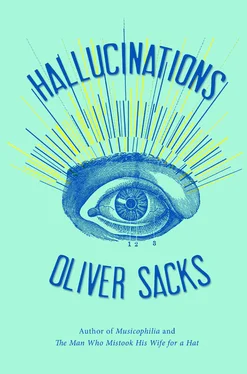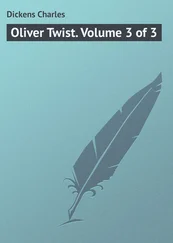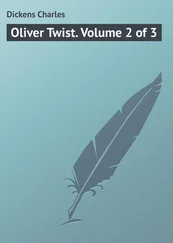Impairment of the sense of smell may appear early in Parkinson’s disease and may perhaps predispose to smell hallucinations as well. But even in the absence of a noticeable impairment of smell, as Landis and Burkhard suggested in a 2008 paper, patients with incipient Parkinson’s disease may have olfactory hallucinations before they develop motor symptoms.
Curiously, lower plants — cycads, conifers, ferns, mosses, and seaweeds — lack hallucinogenic substances.
Some nonflowering plants, however, contain stimulants, as the Mormons, among others, discovered. Mormons are forbidden to use tea or coffee. But on their long march along the Mormon Trail to Utah, the pioneers who were to found Salt Lake City, the new Zion, noticed a simple herb by the roadside, an infusion of which (“Mormon tea”) refreshed and stimulated the weary pilgrims. The herb was ephedra, which contains ephedrine, chemically and pharmacologically akin to the amphetamines.
Quite by accident, Hofmann discovered the hallucinogenic powers of LSD when he synthesized a new batch of the chemical in 1943. He must have absorbed some through his fingertips, for later that day he began to feel odd and went home, thinking he had a cold. As he lay in bed, he experienced “an uninterrupted stream of fantastic images of extraordinary plasticity and vividness and accompanied by an intense kaleidoscopic play of colors.” Jay Stevens, in his book Storming Heaven: LSD and the American Dream , recounted what came next:
Suspecting that LSD-25 had caused these fireworks, Hofmann decided to test this hypothesis.… [A few days later] he dissolved what he thought was a prudently infinitesimal amount of the drug — 250 millionths of a gram — in a glass of water and drank it down. [Forty minutes later] he recorded a growing dizziness, some visual disturbance, and a marked desire to laugh. Forty-two words later he stopped writing altogether and asked one of his lab assistants to call a doctor before accompanying him home. Then he climbed onto his bicycle — wartime shortages having made automobiles impractical — and pedaled off into a suddenly anarchic universe.
I am quoting from the translation provided by David Ebin in his excellent book The Drug Experience: First-Person Accounts of Addicts, Writers, Scientists, and Others .
Louis Lewin, a German pharmacologist, published the first scientific analysis of the peyote cactus in 1886, and it was named Anhalonium lewinii in his honor. Later, he sought to classify various psychoactive substances based on their pharmacological effects, and he divided them into five general groups: euphoriants or sedatives (like opium), inebriants (like alcohol), hypnotics (like chloral and kava), excitants (like amphetamine and coffee), and hallucinogens, which he called phantastica. Many drugs, he noted, had overlapping and paradoxical effects, so that stimulants or sedatives could sometimes be as hallucinogenic as peyote.
Benny Shanon uses this phrase as the title of his remarkable book The Antipodes of the Mind , which is based on personal experience as well as extensive cultural and anthropological experience with the South American hallucinogen ayahuasca. Ayahuasca is, in fact, a blend of two plants: Psychotria viridis and Banisteriopsis caapi , neither of which has any hallucinogenic power by itself. The leaves of Psychotria contain dimethyltryptamine (DMT), a very powerful hallucinogen — but DMT, if taken by mouth, is deactivated in the gut by monoamine oxidase (MAO). Banisteriopsis , however, contains compounds that inhibit the MAO and so allow the DMT to be absorbed. “When one thinks about it,” Shanon writes, “the discovery of Ayahuasca is indeed amazing. The number of plants in the rain forest is enormous, the number of their possible pairings astronomical. The common sense method of trial and error would not seem to apply.”
Breslaw’s account is included in David Ebin’s book The Drug Experience .
I have discussed neurological aspects of time and motion perception, as well as cinematic vision, at greater length in two articles, “Speed” and “In the River of Consciousness.”
Very little was known in the early 1960s about how psychoactive drugs worked, and early research by Timothy Leary and others at Harvard, as well as the work of L. Jolyon West and Ronald K. Siegel at UCLA in the 1970s, focused mostly on the experiences of hallucinogens rather than their mechanisms. In 1975, Siegel and West published a wide-ranging collection of essays in their book Hallucinations: Behavior, Experience, and Theory . Here West set out (as he had in previous work) his release theory of hallucination.
It is now known that stimulants like cocaine and the amphetamines stimulate the “reward systems” of the brain, which are largely mediated by the neurotransmitter dopamine; this is also the case with opiates and alcohol. The classical hallucinogens — mescaline, psilocybin, LSD, and probably DMT — act by boosting serotonin in the brain.
When, decades later, I told this story to my friend Tom Eisner, an entomologist, I mentioned the spider’s philosophical tendencies and Russellian voice. He nodded sagely and said, “Yes, I know the species.”
Many years later, I experienced the much gentler effects of sakau, the intoxicating sap of a pepper ( Piper methysticum , also called kava in Polynesia) cultivated in the South Pacific. Drinking sakau has been a central part of Micronesian life, as chewing coca leaves has been in the Andes, for thousands of years; and its use is formalized in elaborate sakau rituals. I described the effects of sakau at length in The Island of the Colorblind; it may evoke a delicious sense of floating and ease, as well as a variety of visual illusions or hallucinations.
A migraine headache often occurs on only one side (hence the term, which derives from the Greek for “hemi” and “cranium”). But it can also be on both sides, and can range from a dull or throbbing ache to excruciating pain, as J. C. Peters described in his 1853 A Treatise on Headache:
The character of the pains varied very much; most frequently they were of a hammering, throbbing or pushing nature.… [in other cases] pressing and dull … boring with sense of bursting … pricking … rending … stretching … piercing … and radiating.… In a few cases it felt as if a wedge was pressed into the head, or like an ulcer, or as if the brain was torn, or pressed outwards.
This woman, Ingrid K., also reported that she sometimes has “another strange experience just before the migraine … I think I recognize everyone I see. I don’t know who they are … but everyone looks familiar.” Other correspondents have described a similar “hyperfamiliarity” at the start of migraine — and this feeling is occasionally part of an epileptic aura, as Orrin Devinsky and his colleagues have described.
When Hippocrates wrote “On the Sacred Disease,” he was bowing to the then-popular notion of epilepsy’s divine origin, but he dismisses this in his opening sentence: “The disease called sacred … appears to me no more sacred than other diseases, but has a natural cause from which it originates, like other affections.”
Beginning in 1861, when he was twenty-four, Hughlings Jackson published many major papers — on epilepsy, aphasia, and other subjects, as well as what he called “evolution and dissolution in the nervous system.” A selection of these, filling two large volumes, was published in 1931, twenty years after his death. In his later years, Jackson published a series of twenty-one short, gemlike papers in the Lancet under the title Neurological Fragments . These were collected and published in book form in 1925.
Читать дальше












